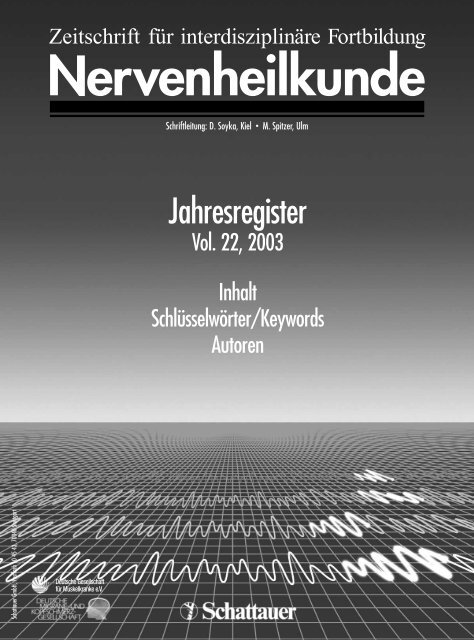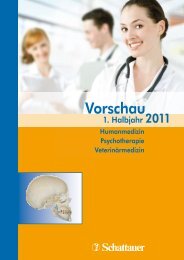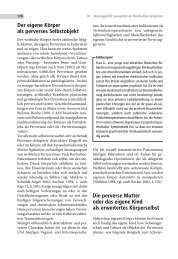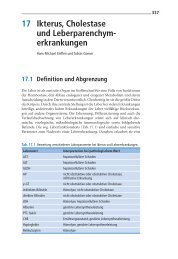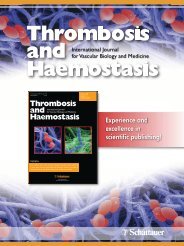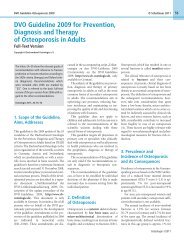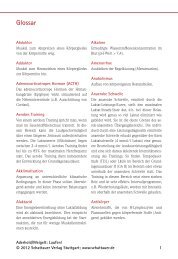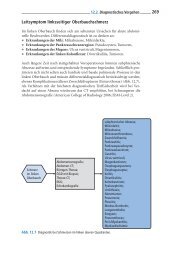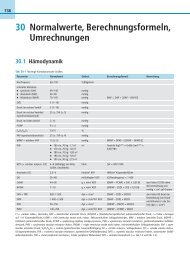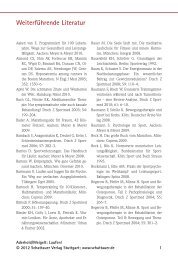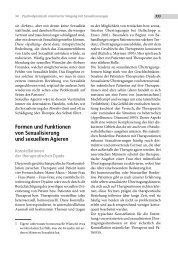Nervenheilkunde - Schattauer GmbH
Nervenheilkunde - Schattauer GmbH
Nervenheilkunde - Schattauer GmbH
Sie wollen auch ein ePaper? Erhöhen Sie die Reichweite Ihrer Titel.
YUMPU macht aus Druck-PDFs automatisch weboptimierte ePaper, die Google liebt.
<strong>Schattauer</strong> <strong>GmbH</strong>, Postfach 10 45 43, 70040 Stuttgart<br />
Zeitschrift für interdisziplinäre Fortbildung<br />
<strong>Nervenheilkunde</strong><br />
Deutsche Gesellschaft<br />
für Muskelkranke e.V.<br />
Schriftleitung: D. Soyka, Kiel ● M. Spitzer, Ulm<br />
Jahresregister<br />
Vol. 22, 2003<br />
Inhalt<br />
Schlüsselwörter/Keywords<br />
Autoren
Inhalt<br />
Editorial<br />
Original- und Übersichtsarbeiten<br />
Original and Review Articles<br />
© 2003 <strong>Schattauer</strong> <strong>GmbH</strong><br />
M. Spitzer 1, 57, 113, 165, 220, 281, 328, 379, 427, 486<br />
Zertifizierte Fortbildung<br />
B. Neundörfer<br />
Die diabetische Polyneuropathie 4<br />
The diabetic neuropathy<br />
J. G. Heckmann, C. J. G. Lang, B. Neundörfer<br />
Hypoglykämische Enzephalopathie 11<br />
Hypoglycemic encephalopathy<br />
B. Fraunberger, H. Stefan<br />
Hormonelle Einflüsse bei Frauen mit Epilepsie 15<br />
Hormonal influences in women with epilepsy<br />
F. Kiefer, K. Wiedemann<br />
Neuroendokrinologie der Alkoholabhängigkeit – Einfluss auf Affekt, Alkoholappetenz und Craving 19<br />
Neuroendocrinology of alcoholism: effects upon emotions and craving<br />
G. W. Eschweiler, H. Wormstall, M. Bartels<br />
Was unterscheidet die Subtypen der Creutzfeldt-Jakob-Krankheit von anderen Demenzen mit initialen<br />
psychiatrischen Auffälligkeiten? 24<br />
What do the subtypes of Creutzfeldt-Jakob-disease (CJD) separate from other dementias with initial<br />
psychiatric symptoms?<br />
G. Ulm, W. Straub, G. Fox, U. Achenbach<br />
Besserung psychiatrischer Störungen bei älteren Parkinson-Patienten durch Umstellung<br />
von Dopaminagonisten auf den COMT-Hemmer Entacapon – Ergebnisse einer offenen Studie 30<br />
Improvement of psychiatric symptoms in elderly Parkinsonian patients by change of dopamine<br />
agonist treatment to the COMT inhibitor entacapone – results of a drug surveillance study<br />
H. J. Koch, M. Vogel, D. Fischer-Barnicol, A. Szecsey<br />
Orexine: Wirkungsspektrum und mögliche therapeutische Indikationen multifunktionaler Peptide 35<br />
Orexins: spectrum of effects and potential therapeutical indications of multifunctional peptides<br />
F. Keller, L. Konopka, J. M. Fegert, A. Naumann<br />
Prozessaspekte der Zufriedenheit von Jugendlichen in stationär-psychiatrischer Behandlung 40<br />
Patient satisfaction of adolescents during in-patient psychiatric treatment: a process-oriented approach<br />
R. M. Kirchhoff, G. M. Kirchhoff, G. Schäcke<br />
Die gutachtliche Beurteilung psychischer Spätschäden nach Konzentrationslagerhaft im Rahmen<br />
von Verschlimmerungsanträgen bei Verfolgungsleiden 47<br />
Expert opinion about psychiatric long term damages by imprisonment in concentration camp in case<br />
of applications for worsening of persecution<br />
J. M. Fegert<br />
Möglichkeiten und Grenzen psychopharmakologischer Forschung im Kindesalter 60<br />
Possibilities and limits of psychopharmacological research in children<br />
A. G. Hildebrandt<br />
Initiativen der Bundesregierung zur Verbesserung der Arzneimittelsicherheit für Kinder und Jugendliche 66<br />
German federal government initiatives for improving the safety of prescription drugs for children<br />
and youths<br />
H.-J. Weber<br />
Konzepte pädiatrischer Studien – Ethische Fragen in der Pharmaforschung aus der Sicht<br />
der forschenden pharmazeutischen Industrie 70<br />
Strategies for pediatric trials – Ethical aspects of drug research in view of the research-based<br />
pharmaceutical industry<br />
ZERTIFIZIERTE<br />
CME<br />
Continuing Medical Education<br />
<strong>Nervenheilkunde</strong><br />
FORTBILDUNG<br />
II<br />
<strong>Nervenheilkunde</strong> 2003
ZERTIFIZIERTE<br />
CME<br />
Continuing Medical Education<br />
<strong>Nervenheilkunde</strong><br />
FORTBILDUNG<br />
ZERTIFIZIERTE<br />
CME<br />
Continuing Medical Education<br />
<strong>Nervenheilkunde</strong><br />
FORTBILDUNG<br />
© 2003 <strong>Schattauer</strong> <strong>GmbH</strong><br />
J. M. Fegert<br />
Ethische und rechtliche Probleme bei Behandlungen schizophrener Patienten mit Neuroleptika<br />
im Kindes- und Jugendalter 75<br />
Ethical and legal issues in treatment of schizophrenic patients with neuroleptics in childhood and youth<br />
M. Gerlach, T. Banaschewski, A. Warnke, A. Rothenberger<br />
Ist ein Parkinson-Syndrom als Spätfolge einer Methylphenidatbehandlung im Kindesalter möglich?<br />
Eine empirische Standortbestimmung 80<br />
Parkinson’s disease following methylphenidate administration in childhood?<br />
An empirical assessment of the current situation<br />
M. Döpfner, T. Banaschewski, J. Schmidt, H. Uebel, K. Schmeck, W. D. Gerber, M. Günter,<br />
U. Knölker, M. Gehrke, F. Häßler, E. Möhler, M. Brünger, C. Ose, R. Fischer, F. Poustka,<br />
G. Lehmkuhl, A. Rothenberger<br />
Langzeitwirksames Methylphenidat bei Kindern mit Aufmerksamkeitsdefizit-<br />
Hyperaktivitätsstörungen – Eine multizentrische Studie 85<br />
Long-acting methylphenidate preparation in children with ADHD – a multicenter study<br />
Zertifizierte Fortbildung<br />
J. M. Fegert, R. Findling, G. deSmedt und die International Disruptive Behaviour Disorder<br />
Study Group<br />
Risperidon zur Behandlung aggressiv-impulsiven Verhaltens bei Kindern und Jugendlichen mit<br />
Intelligenz im unteren Durchschnittsbereich, Lernbehinderung und leichter geistiger Behinderung 93<br />
Risperidone for treatment of aggressive-impulsive behaviour in children and adolescents with<br />
low-average-intelligence, learning disability and mild mental disorder<br />
M. Spitzer<br />
Entwicklungsneurobiologie höherer geistiger Leistungen 98<br />
Developmental cognitive neuroscience<br />
D. Schmidt, C. E. Elger<br />
Klinischer Nutzen einer Levetiracetambehandlung bei Epilepsie –<br />
Eine Anwendungsbeobachtung an 774 Patienten 104<br />
Clinical benefit of Levetiracetam add-on treatment in 774 patients with chronic, drug-refractory epilepsy<br />
B. Rautenstrauß<br />
Molekulare Variabilität der monogenen peripheren Neuropathien 116<br />
Molecular variability of monogenic peripheral neuropathies<br />
D. Heuss, B. Schlotter-Weigel, C. Sommer<br />
Vaskulitische Neuropathien 122<br />
Diagnosis and therapy of vasculitic neuropathy<br />
M. Mäurer, K. V. Toyka, R. Gold<br />
Therapie immunvermittelter Neuropathien 131<br />
Therapy of immune mediated neuropathies<br />
Zertifizierte Fortbildung<br />
M. J. Hecht<br />
Therapie der Amyotrophen Lateralsklerose – aktueller Stand 136<br />
Current treatment of amyotrophic lateral sclerosis<br />
M. C. Walter, H. Lochmüller, D. Pongratz<br />
Sporadische Einschlusskörpermyositis – Ätiologie, Pathogenese und Therapieoptionen 142<br />
Sporadic inclusion body myositis – etiology, pathogenesis and therapeutic options<br />
P. Reilich, D. Pongratz<br />
Botulinumtoxin A beim chronischen myofaszialen Schmerzsyndrom 146<br />
Botulinum toxin A in the treatment of chronic myofascial pain<br />
III<br />
<strong>Nervenheilkunde</strong> 2003
© 2003 <strong>Schattauer</strong> <strong>GmbH</strong><br />
G. Kreutz, M. O. Russ, S. Bongard, H. Lanfermann<br />
Zerebrale Korrelate des Musikhörens – Eine fMRT-Studie zur Wirkung »fröhlicher« und<br />
»trauriger« klassischer Musik 150<br />
Cerebral correlates of music listening. An fMRI-study on the effects of ”happy“ and ”sad“ classical music<br />
T. Kammer, A. Thielscher<br />
Physikalische und physiologische Grundlagen der transkraniellen Magnetstimulation 168<br />
The physical and physiological fundamentals of transcranial magnetic stimulation<br />
C. Schönfeldt-Lecuona, M. Spitzer, U. Herwig<br />
Positionierungsstrategien für die transkranielle Magnetstimulation 177<br />
Positioning strategies of the transcranial magnetic stimulation<br />
C. Plewnia, G. W. Eschweiler<br />
Kortikale Exzitabilität – Messung und Modulation 182<br />
Cortical excitability – measurement and modulation<br />
G. W. Eschweiler, C. Plewnia, B. Wild<br />
Gemeinsamkeiten und Unterschiede der therapeutischen transkraniellen Magnetstimulation<br />
und der Elektrokrampftherapie 189<br />
Similarities and differences of therapeutic transcranial magnetic stimulation and electroconvulsive<br />
therapy<br />
U. Herwig, M. Spitzer, C. Schönfeldt-Lecuona<br />
Hat die antidepressive TMS klinische Bedeutung? Argumentation für eine multizentrische Studie 196<br />
Does antidepressant TMS exert a clinically meaningful effect? Arguing for a multicentric study<br />
A. Hempel, F. L. Giesel, G. W. Eschweiler, P. Schönknecht, M. Essig, J. Schröder<br />
Frontale Dysfunktion und TMS 200<br />
Frontal dysfunction and TMS<br />
E. Habermeyer, I. Kamps, E. Gouzoulis-Mayfrank<br />
Transsexualismus und psychische Komorbidität – Probleme bei Begutachtung und Therapie 204<br />
Transsexualism and mental comorbidity: problems with medical expert opinion and therapy<br />
H.-H. Eckstein<br />
Evidenzbasierte Indikationen zur chirurgischen Therapie extrakranieller Karotisstenosen 222<br />
Evidence based indications for surgical therapy of extracranial carotid stenoses<br />
S. Pollmann<br />
Funktionelle Neuroanatomie der selektiven visuellen Aufmerksamkeit 233<br />
Functional neuroanatomy of selective visual attention<br />
R. Schlösser, B. Forstmann, S. Köhler, M. Friederich, M. Bolz, J. R. Reichenbach, G. Vucurevic,<br />
P. Stoeter, H. Sauer<br />
Subkomponenten des Arbeitsgedächtnisses – Untersuchungen mit der ereigniskorrelierten<br />
funktionellen Magnetresonanztomographie (fMRT) 239<br />
Subcomponents of working memory: Studies with event-related functional magnetic resonance<br />
imaging (fMRI)<br />
T. Kircher<br />
Sprache, Gehirn und Schizophrenie 245<br />
Language, brain and schizophrenia<br />
M. E. Keck<br />
Neurobiologische Grundlagen des therapeutischen Einsatzes der repetitiven transkraniellen<br />
Magnetstimulation (rTMS) in der Psychiatrie 253<br />
The neurobiological basis of therapeutic use of repetitive transcranial magnetic stimulation (rTMS)<br />
D. Soyka<br />
Psychische Befunde bei Migräne und Kopfschmerz vom Spannungstyp – eine Übersicht 261<br />
Psychic findings in migraine and tension-type headache – a review<br />
IV<br />
<strong>Nervenheilkunde</strong> 2003
ZERTIFIZIERTE<br />
CME<br />
Continuing Medical Education<br />
<strong>Nervenheilkunde</strong><br />
FORTBILDUNG<br />
ZERTIFIZIERTE<br />
CME<br />
Continuing Medical Education<br />
<strong>Nervenheilkunde</strong><br />
FORTBILDUNG<br />
© 2003 <strong>Schattauer</strong> <strong>GmbH</strong><br />
K.-E. Bühler, M. König<br />
Depression und Biografie 267<br />
Depression and biography<br />
Zertifizierte Fortbildung<br />
H. Spießl, B. Hübner-Liebermann, C. Cording<br />
Therapie unipolarer und bipolarer Depressionen bei einer klinischen Klientel 272<br />
Treatment of unipolar and bipolar depression among a clinical population<br />
C. Bischoff<br />
Kompartmentsyndrome in der Neurologie 283<br />
Compartment syndromes in neurology<br />
A. O. Ceballos-Baumann<br />
Demenz bei Parkinson-Syndromen – Klinik und Therapie 287<br />
Dementia in parkinsonism – clinical and therapeutic aspects<br />
D. Sander, K. Winbeck, T. Etgen, M. Landgrebe, B. Conrad<br />
Neues in der Schlaganfallprävention: moderne Differenzialtherapie mit Thrombozytenfunktionshemmern 295<br />
New aspects of stroke prevention: modern differential therapy with platelet inhibitors<br />
Zertifizierte Fortbildung<br />
A. Berthele, B. Conrad<br />
Neues zur Neuroborreliose 301<br />
New aspects in neuroborreliosis<br />
M. von Rad, H. Gündel<br />
Neue Entwicklungen in der Psychosomatik 307<br />
New trends in psychosomatic medicine<br />
T. Banaschewski, H. Uebel, R. Fischer, A. Rothenberger<br />
Methylphenidatbehandlung von Kindern und Jugendlichen mit hyperkinetischen Störungen –<br />
eine Anwendungsbeobachtung bei niedergelassenen Ärzten 311<br />
Treatment of attentiondeficit/hyperactivity disorder with methylphenidate – a post-marketingsurveillance<br />
study in community care<br />
H. Haltenhof<br />
Suizidalität bei Menschen mit einer schizophrenen Psychose – eine fallbezogene Darstellung 318<br />
Suicidality in patients with schizophrenia – a case-orientated report<br />
H. Neumann, P. Bayerl<br />
Bewegungswahrnehmung – die Illusion der Realität 322<br />
The perception of motion – the illusion of reality<br />
F. Padberg, B. Zinka, P. Zwanzger, R. Ella, R. Rupprecht, M. E. Keck, H.-J. Möller<br />
Präfrontale repetitive transkranielle Magnetstimulation in der Therapie depressiver Erkrankungen 331<br />
Prefrontal repetitive transcranial magnetic stimulation as treatment in major depressive episodes<br />
S. Cohrs, G. Hajak<br />
Der Einfluss repetitiver transkranieller Magnetstimulation auf die Stimmung gesunder Probanden 341<br />
The influence of repetitive transcranial magnetic stimulation on mood in healthy subjects<br />
M. E. Keck, T. Welt, A. Erhardt, M. B. Müller, I. Sillaber<br />
Neuroendokrine Effekte der repetitiven transkraniellen Magnetstimulation –<br />
Fokus auf Dopamin und Vasopressin 346<br />
Neuroendocrinological changes induced by transcranial magnetic stimulation (rTMS) –<br />
a focus on dopamine and vasopressin<br />
B. Langguth, P. Eichhammer, A. Kharraz, R. Wiegand, G. Hajak<br />
Repetitive transkranielle Magnetstimulation bei Schizophrenie – Vorläufige Ergebnisse 350<br />
Repetitive transcranial magnetic stimulation in schizophrenia (preliminary results)<br />
V<br />
<strong>Nervenheilkunde</strong> 2003
ZERTIFIZIERTE<br />
CME<br />
Continuing Medical Education<br />
<strong>Nervenheilkunde</strong><br />
FORTBILDUNG<br />
ZERTIFIZIERTE<br />
CME<br />
Continuing Medical Education<br />
<strong>Nervenheilkunde</strong><br />
FORTBILDUNG<br />
© 2003 <strong>Schattauer</strong> <strong>GmbH</strong><br />
P. Eichhammer, B. Langguth, A. Kharraz, R. Wiegand, G. Hajak<br />
TMS: Neue Einsatzmöglichkeiten in der neurophysiologischen Charakterisierung von Psychopharmaka<br />
und der biologischen Phänotypisierung psychischer Erkrankungen 354<br />
Transcranial magnetic stimulation: New possibilities in characterizing central acting drugs and in<br />
phenotyping psychiatric diseases<br />
Zertifizierte Fortbildung<br />
A. Conca, W. Hrubos, J. Di Pauli, H. Hinterhuber, W. Peschina, P. König, A. Hausmann<br />
Transkranielle Magnetstimulation und bildgebende Verfahren des ZNS 359<br />
TMS and neuroimaging<br />
H. C. Diener, H. Landen, K. Stauch<br />
Almotriptan in der Routine-Behandlung akuter Migräneattacken: eine Post-Marketing-Studie<br />
mit 899 Patienten 365<br />
Almotriptan in the treatment of acute migraine attacks: a post-marketing study in 899 patients<br />
T. Lücke, H. J. Christen, N. Kanzelmeyer, A. Kohlschütter, J. H. H. Ehrich, A. M. Das<br />
Zur Neurologie bei der immuno-ossären Dysplasie Schimke (IODS) 369<br />
Remarks on the neurology of immuno-osseous dysplasia, Schminke type (IODS)<br />
W. Tackmann<br />
Polyneuropathien – Einführung zum Thema 382<br />
Polyneuropathies – introduction to topic<br />
R. Kaiser<br />
Labordiagnostik immunvermittelter Polyneuropathien 385<br />
Laboratory investigation of immune mediated polyneuropathies<br />
M. Sabolek, A. Storch<br />
Das Restless-Legs-Syndrom: Klinik, Diagnose und Therapie 390<br />
Restless legs syndrome: clinical features, diagnosis and treatment<br />
M. Stöhr<br />
Polyneuropathie-Abklärung: Was leistet die Elektrophysiologie? 397<br />
Polyneuropathy – electrophysiologic approach<br />
C. Bischoff, J. Machetanz<br />
Polyneuropathie und Engpasssyndrome 401<br />
Polyneuropathy and entrapment syndromes<br />
Zertifizierte Fortbildung<br />
A. Meyer<br />
Die Therapie der Polyneuropathien 407<br />
Treatment of polyneuropathies<br />
D. Schmidt<br />
Ungünstiges Nutzen-Risiko-Profil der Hochdosis-Therapie mit Antiepileptika: eine Übersicht 411<br />
Unfavorable risk-benefit profile of high dose therapy with antiepileptic drugs: a survey<br />
M.-A. Edel, K. Schmidt<br />
Phobische, Angst- und Persönlichkeitsstörungen sowie soziale Beeinträchtigung ambulanter<br />
erwachsener Patienten mit Aufmerksamkeitsdefizit-/Hyperaktivitätsstörungen 415<br />
Phobic/anxiety and personality disorders and social impairment in adult outpatients with<br />
attention-deficit/hyperactivity disorder (ADHD)<br />
M. Papousˇek<br />
Regulationsstörungen der frühen Kindheit erkennen und behandeln –<br />
Ein diagnostisches und therapeutisches Konzept 432<br />
Regulatory disorders in infancy: a diagnostic and therapeutic concept<br />
VI<br />
<strong>Nervenheilkunde</strong> 2003
ZERTIFIZIERTE<br />
CME<br />
Continuing Medical Education<br />
<strong>Nervenheilkunde</strong><br />
FORTBILDUNG<br />
ZERTIFIZIERTE<br />
CME<br />
Continuing Medical Education<br />
<strong>Nervenheilkunde</strong><br />
FORTBILDUNG<br />
© 2003 <strong>Schattauer</strong> <strong>GmbH</strong><br />
Zertifizierte Fortbildung<br />
W. Kreis<br />
Pharmakotherapie von ADHD – Biologische Grundlagen, Chancen und Grenzen 438<br />
Pharmacotherapy of ADHD – biology, chances and limitations<br />
M. Ennemoser<br />
Effekte des Fernsehens im Vor- und Grundschulalter –<br />
Ursachen, Wirkmechanismen und differenzielle Effekte 443<br />
Television effects in kindergarten and elementary school grades – causes, explanatory hypotheses,<br />
and differential effects<br />
M. Myrtek<br />
Fernsehkonsum bei Schülern: ambulante psychophysiologische Untersuchungen im Alltag 454<br />
Television consumption in schoolboys: ambulatory psychophysiological monitoring in everyday life<br />
H. Hinke<br />
Die PISA-Studie – Aussagen über die familien-, sozial- und bildungspolitischen Bedingungen in der<br />
Bundesrepublik und im Vergleich der Bundesländer. Welche Zukunftsszenarien ergeben sich hieraus<br />
für Bayern? 459<br />
The PISA study – statements on family, social and educational conditions in Germany,<br />
consequences in Bavaria<br />
E. Friederichs<br />
Entwicklungspädiatrie vom Säugling bis zum Jugendlichen – Notwendigkeit effizienterer<br />
Präventionsleistungen im Hinblick auf Lern- und Leistungsprobleme im Vorschul- und Schulalter 462<br />
Developmental pediatrics from newborn to adolescent: Need for more efficient preventive disease<br />
management with respect to learning disabilities within the preschool and school age<br />
W. Hollmann, H. K. Strüder, C. V. M. Tagarakis<br />
Körperliche Aktivität fördert Gehirngesundheit und -leistungsfähigkeit – Übersicht und eigene Befunde 467<br />
Physical activity improves brain health and performance – survey and own findings<br />
K.-E. Bühler, S. Pagels<br />
Der Einfluss von Biographie, Lebensereignissen und chronischen Schwierigkeiten auf den Verlauf<br />
stationärer Therapie Depressiver 475<br />
The influence of biography, life events and chronic stress on the course of treatment of depressive<br />
subjects<br />
J. G. Heckman, B. Stemper, M. Dütsch, R. Handschu, C. Rauch, B. Tomandl<br />
Thrombolyse-Therapie beim akuten Schlaganfall 488<br />
Thrombolysis therapy in acute stroke<br />
Zertifizierte Fortbildung<br />
F. Kerling, H. Stefan<br />
Neue Antiepileptika –- ihr Stellenwert in der aktuellen Therapie 494<br />
New antiepileptic drugs – their position in current therapy<br />
J. Herzog, G. Deuschl, J. Volkmann<br />
Die tiefe Hirnstimulation in der Therapie des idiopathischen Parkinson-Syndroms 498<br />
Deep brain stimulation in the treatment of idiopathic Parkinson´s disease<br />
B. Neundörfer<br />
Glatirameracetat und Mitoxantron in der Behandlung der Multiplen Sklerose 504<br />
Glatirameracetate and Mitoxantron in MS-therapy<br />
H.-P. Haack<br />
Genialisierung durch Krankheit 509<br />
Brilliance due to illness<br />
VII<br />
<strong>Nervenheilkunde</strong> 2003
Bundeseinheitliche Konsensuspapiere der<br />
Muskelzentren im Auftrag der Deutschen<br />
Gesellschaft für Muskelkranke e.V. (DGM) –<br />
Consensus Paper<br />
Der besondere Fall – Special Case Report<br />
Geist & Gehirn – Mind & Brain<br />
Erfahrungsberichte aus Klinik und Praxis<br />
Die Internationale Klassifikation<br />
von Kopfschmerzerkrankungen,<br />
2. Auflage –<br />
The International Classification on<br />
Headache Disorders, 2. Edition<br />
VIII<br />
© 2003 <strong>Schattauer</strong> <strong>GmbH</strong><br />
P. Garlipp, M. Ziegenbein, H. Haltenhof<br />
Zwischen Forensifizierung und Neglect? Zum psychiatrischen und juristischen Umgang<br />
mit gewalttätigen schizophrenen Menschen in der Allgemeinpsychiatrie 514<br />
Between Forensification and neglect? Psychiatric and legal aspects of dealing with violent<br />
schizophrenic patients in general psychiatry<br />
D. Schmidt, C. E. Elger, B. J. Steinhoff, H. Stefan<br />
Wann ist Gabapentin zur Behandlung von Epilepsien vorteilhafter als Carbamazepin? 520<br />
In which cases is gabapentin more advantageous than carbamazepine in the treatment of epilepsy?<br />
Zertifizierte Fortbildung<br />
A. von Moers, V. Straub, E. Wilichowski<br />
Diagnostik kongenitaler Muskeldystrophien 210<br />
Diagnostics in congenital muscular dystrophies<br />
ZERTIFIZIERTE<br />
CME<br />
Continuing Medical Education<br />
<strong>Nervenheilkunde</strong><br />
FORTBILDUNG<br />
B. Heindl, C. Schäfer, C. Davis, A. Putzhammer<br />
“He was ugly, he was strong, he had dignity” – Kasuistik einer Folie à deux 157<br />
“He was ugly, he was strong, he had dignity” – case report of a folie à deux<br />
A. Skrabal, U. Schulze, J. M. Fegert<br />
Psyche, Soma und ärztliche Vorurteile bei der Patientenzuweisung in die Kinder- und Jugendpsychiatrie<br />
und Psychotherapie – Zwei Kasuistiken 419<br />
Psyche, soma and medical prejudices on patient admission to child and adolescent psychiatry wards –<br />
2 case reports<br />
M. de Groot, A. Günther, H.-J. Kühn, A. Wagner<br />
Intrathekale IgA-Synthese und vermutete Multiple Sklerose – Analyse von 14 Fällen 525<br />
Intrathecal IgA-synthesis and suspected multiple sclerosis – analysis of 14 cases<br />
M. Spitzer 54, 108, 161, 216, 278, 325, 373, 424, 482, 530<br />
J. M. Fegert<br />
ADHS – Führerschein und Medikation 376<br />
Einführung in die Klassifikation 531<br />
Anleitung zum Gebrauch der Klassifikation 534<br />
Klassifikation<br />
Primäre Kopfschmerzerkrankungen<br />
536<br />
1. Migräne 545<br />
2. Kopfschmerz vom Spannungstyp 557<br />
3. Clusterkopfschmerz und andere trigemino-autonome Kopfschmerzerkrankungen 563<br />
4. Andere primäre Kopfschmerzen<br />
Sekundäre Kopfschmerzerkrankungen<br />
568<br />
Einleitung sekundäre Kopfschmerzen 574<br />
5. Kopfschmerz zurückzuführen auf ein Kopf- und/oder HWS-Trauma 576<br />
6. Kopfschmerz zurückzuführen auf Gefäßstörungen im Bereich des Kopfes oder des Halses 582<br />
7. Kopfschmerz zurückzuführen auf nichtvaskuläre intrakraniale Störungen 593<br />
8. Kopfschmerz zurückzuführen auf eine Substanz oder deren Entzug 603<br />
9. Kopfschmerz zurückzuführen auf eine Infektion 616<br />
10. Kopfschmerz zurückzuführen auf Störungen der Homöostase<br />
11. Kopf- oder Gesichtsschmerzen zurückzuführen auf Erkrankungen des Schädels sowie von Hals,<br />
Augen, Ohren, Nase, Nasennebenhöhlen, Zähnen, Mund oder anderen Gesichts- oder<br />
621<br />
Schädelstrukturen 628<br />
12. Kopfschmerzen zurückzuführen auf psychiatrische Störungen 635<br />
<strong>Nervenheilkunde</strong> 2003
Supplement<br />
Aktueller Stand zur Forschung und Therapie<br />
der Multiplen Sklerose<br />
© 2003 <strong>Schattauer</strong> <strong>GmbH</strong><br />
Kraniale Neuralgien, zentraler und primärer Gesichtsschmerz und andere Kopfschmerzen<br />
13. Kraniale Neuralgien und zentrale Ursachen von Gesichtschmerzen 638<br />
14. Andere Kopfschmerzen, kraniale Neuralgien, zentrale oder primäre Gesichtsschmerzen 647<br />
Anhang<br />
Vorläufige und experimentelle Diagnosen 648<br />
Glossar 659<br />
Anhang zur deutschsprachigen Übersetzung: 661<br />
Derzeit aktuelle Therapieempfehlungen der Deutschen Migräne- und Kopfschmerzgesellschaft<br />
Synopsis der deutschsprachigen und englischsprachigen Diagnosen<br />
F. Heidenreich, M. Freidel<br />
MSTKG-Diagnosekriterien und Umsetzung in der Praxis S2<br />
New MS diagnostic criteria and their clinical management<br />
M. Stangel, H. Lassmann<br />
Multiple Sklerose: Pathologie und Regeneration S8<br />
Multiple sclerosis: pathology and regeneration<br />
H. F. Petereit, E. Sindern<br />
Prädiktive Marker bei Multipler Sklerose S13<br />
Predictive markers in multiple sclerosis<br />
R. Gold, H.-P. Hartung<br />
Aktueller Therapieüberblick und zukünftige Therapiestrategien der Multiplen Sklerose S16<br />
Update on recent and future therapeutic strategies in multiple sclerosis<br />
H. Wiendl, R. Hohlfeld<br />
Therapieansätze bei der Multiplen Sklerose –<br />
Lektionen aus fehlgeschlagenen und abgebrochenen Studien S25<br />
Therapeutical approaches in multiple sclerosis – experiences from failed or terminated trials<br />
A. Bayas, R. Gold<br />
Symptomatische Therapie der Multiplen Sklerose S32<br />
Symptomatic treatment of multiple sclerosis<br />
P. Flachenecker, P. Rieckmann<br />
Sozioökonomische Aspekte der Multiplen Sklerose S39<br />
Socioeconomic aspects of multiple sclerosis<br />
S. Poser, B. Kitze, A. Bitsch, T. Bogumil, A. Dressel, H. Tumani, F. Weber<br />
Die primär chronisch progrediente Multiple Sklerose S43<br />
The primary progressive multiple sclerosis<br />
O. Aktas, K.-P. Wandinger, F. Zipp<br />
Therapeutisch relevante MS-Forschung – ein Ausblick S46<br />
Therapeutically relevant MS research – an outlook<br />
P. Calabrese, V. Limmroth, P. Scherer, S. Bamborschke<br />
Neuropsychologische Aspekte der MS S51<br />
Neuropsychological aspects in multiple sclerosis<br />
IX<br />
<strong>Nervenheilkunde</strong> 2003
Schlüsselwörter<br />
14-3-3-Protein 24<br />
3D-Kamerasystem 177<br />
α-Dystroglykan 210<br />
Affekt 19<br />
Affektive Störungen 272, 475<br />
Aggression 514<br />
Alexithymie 307<br />
Alkoholabhängigkeit 19<br />
Almotriptan 365<br />
Ältere Patienten 30<br />
Ambulantes Monitoring 454<br />
Amphetamine 80, 438<br />
Amyotrophe Lateralsklerose (ALS) 136<br />
Amyotrophie, diabetische 4<br />
Anatomische Landmarken 177<br />
Antibiotikabehandlung, Langzeit- 302<br />
Antiepileptika 104, 411, 494, 520<br />
Antikonvulsiva 520<br />
Anwendungsbeobachtung 311<br />
APL (altered peptide ligands) S25<br />
Arbeitsgedächtnis 239<br />
Arteriosklerose 369<br />
Arzneimittelentwicklung 70<br />
Arzneimittelforschung 60<br />
Arzneimittelsicherheit 66<br />
Atriales natriuretisches Peptid (ANP) 19<br />
Aufklärung 60<br />
Aufmerksamkeit, selektive 233<br />
Aufmerksamkeitsdefizit-/Hyperaktivitätsstörung<br />
(ADHS) 80, 85, 311, 415, 438<br />
Auto-Antikörper 385<br />
Behandlungszufriedenheit 40<br />
β-Endorphin 19<br />
Beta-Interferon S43<br />
Bewegungsillusion 322<br />
Bewegungswahrnehmung 322<br />
Biografie 267, 475<br />
Biologische Marker S13<br />
Bipolare affektive Störung 272<br />
Bipolare Störung 204<br />
Blasenstörung S32<br />
Botulinumtoxin A 146<br />
Charcot-Marie-Tooth-Erkrankungen<br />
(CMT) 116<br />
Chemokinrezeptor CCR1 S46<br />
Cholinesterase-Hemmer 287<br />
Cladribin S25<br />
Craving 19<br />
Creutzfeldt-Jakob-Krankheit 24<br />
– Codon 129 24<br />
Deletion 116<br />
Delikt 514<br />
Demenz 287<br />
Denkstörungen, formale 245<br />
Deoxyspergualin S25<br />
Depression 196, 253, 261, 267, 272, 311,<br />
346<br />
– psychotische 189<br />
Depressive Symptomatik 350<br />
Der Zauberberg 509<br />
Diabetes mellitus 11<br />
Differenzialdiagnose 419, 525<br />
Doktor Faustus 509<br />
Dopamin 346, 438<br />
– Transporter 80<br />
Dopaminergika 287, 390<br />
Doppelspule 168<br />
Duplikation 116<br />
EEG 359<br />
Einschlusskörpermyositis 142<br />
Elektrokrampftherapie 189<br />
Elektromyographie 397<br />
Emotion 150, 341<br />
Emotionale Beanspruchung 454<br />
Endokrinologie 19<br />
Energiehaushalt 35<br />
Energiekrisenhypothese 146<br />
Entacapon 30<br />
Entwicklungs- und Familienpädiatrie 462<br />
Entwicklungsneurobiologie 98<br />
Entwicklungspsychologie 307<br />
Enzephalopathie 11<br />
Epilepsie 15, 104, 411, 494, 520<br />
– Hochdosistherapie 411<br />
– Überbehandlung 411<br />
Erkrankungsaktivität S13<br />
Evidence-based Medicine 75<br />
Exekutive Funktionen 239<br />
Exzitabilität, kortikale 182, 354<br />
Fatigue S32<br />
Feldverteilung, induzierte 168<br />
Fernsehen 443, 454<br />
Fertilität 15<br />
Folie à deux 157<br />
Forensik 514<br />
Frontal 233<br />
Frontallappen 98<br />
Funktionelle Bildgebung 200, 245<br />
Funktionelle Magnetresonanztomografie (fMRT)<br />
98, 150, 200, 233<br />
– ereigniskorrelierte 239<br />
© 2003 <strong>Schattauer</strong> <strong>GmbH</strong><br />
Gabapentin 520<br />
Gehirngesundheit und -leistungsfähigkeit 467<br />
Geistige Behinderung 93<br />
Geschlechtsidentität 204<br />
Gewalt 514<br />
Glatirameracetat 504<br />
Globus pallidus internus 498<br />
Glukose 11<br />
Glykosylierung 210<br />
Guillain-Barré-Syndrom 131<br />
Hashimoto-Enzephalopathie 24<br />
Hierarchisches lineares Modell 40<br />
Hirninfarkt 295<br />
– ischämischer 488<br />
Hirnphysiologie 341<br />
Hirnstimulation, tiefe 498<br />
Hypoglykämie 11<br />
IgA-Synthese, intrathekale 525<br />
IL-10 S25<br />
IL-4 S25<br />
Immuno-ossäre Dysplasie (IODS) 369<br />
Immunpathogenese S16<br />
Immuntherapie S16<br />
Impfung 302<br />
Infliximab S25<br />
Interferenz 98<br />
Intravenöse Immunglobuline (IVIg) S25<br />
Ischämie 369<br />
Jugendpsychiatrie 40<br />
Karotisstenosen 222<br />
Karotis-TEA 222<br />
Karpaltunnelsyndrom 401<br />
Katamenial 15<br />
Kernspintomographie S13<br />
Kinder 85<br />
Kinder- und Jugendliche 60<br />
– schizophrene Psychosen 75<br />
Kinder- und Jugendpsychiatrie 419<br />
Kindheit, frühe 432<br />
Kognition 239<br />
Kognitive Nebenwirkungen 189<br />
Kognitive Störungen S51<br />
Kollagen VI 210<br />
Kollagenose 385<br />
Komorbidität 415<br />
Kompartmentsyndrome 283<br />
Kontrazeption, hormonelle 15<br />
Konzentrationslager, Spätschäden 47<br />
Kopfschmerz vom Spannungstyp 261<br />
Körperliche Aktivität 467<br />
X<br />
<strong>Nervenheilkunde</strong> 2003
Kortex, temporaler 150<br />
Kortikales Feedback 322<br />
Krankheitskosten S39<br />
Laminin α2 210<br />
Lenercept S25<br />
Leptin 19<br />
Lesekompetenzen 443<br />
Levetiracetam 104<br />
Life-Events 475<br />
Linomid S25<br />
”Magnetic seizure therapy” 189<br />
Magnetresonanztomographie (MRT) S2, 359<br />
– diffusionsgewichtete 24<br />
Magnetstimulation 331<br />
Methylphenidat 80, 85, 311, 438<br />
Migräne 261, 365<br />
Mitoxantron 504<br />
MSTd 322<br />
MT-Areal 322<br />
Multiple Sklerose (MS) 504, 525, S2, S8, S13,<br />
S16, S25, S32, S39, S46, S51<br />
– primär chronisch progrediente (PPMS) S43<br />
Musikwahrnehmung 150<br />
Muskeldystrophie, kongenitale 210<br />
Myofasziales Schmerzsyndrom 146<br />
Mypathie, entzündliche 142<br />
Nahinfrarotspektroskopie 359<br />
Negativsymptomatik 350<br />
Nervenmodell 168<br />
Neurobiologie 253, 307, 346<br />
Neuroborreliose, chronische 302<br />
Neurographie 397, 401<br />
Neuroleptika, atypische 93<br />
Neuronavigation 177<br />
Neuropathie, diabetische autonome 4<br />
– hereditäre motorisch-sensible (HMSN) 116<br />
– multifokale motorische (MMN) 131<br />
– tomakulöse (HNPP) 116<br />
– vaskulitische 122<br />
Neuropathologie S8<br />
Neuropsychologische Diagnostik S51<br />
Neurosarkoidose 385<br />
Neurotizismus 261<br />
Nuclus subthalamicus 498<br />
Off label use 60, 66, 75<br />
Orexine 35<br />
Pädiatrische Studien 70<br />
Parietal 233<br />
Parkinson-Krankheit 30, 80, 287, 498<br />
Peptide 35<br />
Peptidliganden S25<br />
Periodische Beinbewegungen im Schlaf (PLMS)<br />
390<br />
Persönlichkeit 267, 475<br />
Persönlichkeitsfragebögen 267<br />
Persönlichkeitsstörungen 415<br />
Phobien/Angststörungen 415<br />
Phosphodiesterase S46<br />
Pinna-Illusion 322<br />
PISA-Studie 459<br />
Polyneuropathie 382, 385, 397, 401, 407<br />
– diabetische 4<br />
– inflammatorische demyelinisierende (CIDP) 131<br />
Positronen-Emissions-Tomografie (PET) 200, 359<br />
Postexpositionsprophylaxe 302<br />
Posttraumatische Belastungsstörung (PTSD) 307<br />
Prävention 295, 462<br />
Prionprotein 24<br />
Produktinformationen 70<br />
Psychiatrische Klinik 272<br />
Psychiatrische Komorbidität 261<br />
Psychiatrische Symptome 30<br />
Psychopharmaka 272<br />
Psychopharmakologie 182<br />
Psychopharmakotherapie 75<br />
Psychose, symbiontische 157<br />
Pubertät 98<br />
Radikulopathie, diabetische 4<br />
Regulationsstörungen 432<br />
– exzessives Schreien 432<br />
Restless-Legs-Syndrom (RLS) 390<br />
Retardpräparat 85<br />
Risperidon 93<br />
Rundspule 168<br />
Sammlung Prinzhorn 509<br />
Schizophrenie 239, 245, 318, 350, 514<br />
Schlafstörungen 432<br />
Schlaf-Wach-Rhythmus 35<br />
© 2003 <strong>Schattauer</strong> <strong>GmbH</strong><br />
Schmerz 407<br />
Schüler 454<br />
Schulleistungen 443<br />
Schulsystem 459<br />
Schwangerschaft 15<br />
Sexualstörung S32<br />
s-IBM 142<br />
Single-Photon-Emissions-Computertomografie<br />
(SPECT) 359<br />
Spastik S32<br />
Sprache 245<br />
Statine S46<br />
Stenting 222<br />
Stimmung 341<br />
Stimulationspuls 168<br />
Stress 253, 346<br />
Suizidalität 318<br />
Sulfasalazin S25<br />
Symptomatik 382<br />
TGF β2 S25<br />
Thrombolyse 488<br />
Thrombozytenfunktionshemmer 295<br />
Tibialis-anterior-Syndrom 283<br />
TNF-α-Antagonisten S25<br />
Transkranielle Magnetstimulation (TMS) 168,<br />
182, 189, 196, 200, 354, 359<br />
– biphasisch 168<br />
– Doppelpuls 182, 354<br />
– monophasisch 168<br />
– repetitive (rTMS) 182, 253, 331, 341, 346,<br />
350<br />
– stereotaktische 177<br />
Transsexualität 204<br />
Transsexuellengesetz 204<br />
Triggerpunkt 146<br />
Vaskulitis 385<br />
Vasopressin 346<br />
Verhaltensstörung, aggressive 93<br />
Wachstumskurven 40<br />
Wahn, induziert 157<br />
XI<br />
<strong>Nervenheilkunde</strong> 2003
Keywords<br />
14-3-3 protein 24<br />
3D camera system 177<br />
Academic achievement 443<br />
Adolescent psychiatry 40<br />
α-dystroglykan 210<br />
Affective 19<br />
Aggressive behaviour disorder 93<br />
Alcoholism 19<br />
Alexithymia 307<br />
Almotriptan 365<br />
Altered peptide ligands (APL) S25<br />
Ambulatory monitoring 454<br />
Amphetamine 80, 438<br />
Amyotrophic lateral sclerosis (ALS) 136<br />
Amyotrophy, diabetic 4<br />
Anatomical landmarks 177<br />
ANP 19<br />
Antibiotic treatment, long-term 302<br />
Anticonvulsants 520<br />
Antiepileptic drugs 104, 411, 494, 520<br />
Antiplatelet drugs 295<br />
Arteriosclerosis 369<br />
Assault 514<br />
Attention 233<br />
Attention-deficit/hyperactivity disorder (ADHD)<br />
80, 85, 311, 415, 438<br />
Auto-antibodies 385<br />
β-endorphin 19<br />
Beta-interferon S43<br />
Biography 267, 475<br />
Biological marker S13<br />
Bipolar affective disorder 272<br />
Bipolar disorder 204<br />
Botulinum toxin A 146<br />
Brain-Health an performance 467<br />
Carotid stenoses 222<br />
Carotid TEA 222<br />
Carpal tunnel syndrome 401<br />
Catamenial 15<br />
Cerebral infarction, ischemic 488<br />
Charcot-Marie-Tooth diseases (CMT) 116<br />
Chemokine receptor CCR1 S46<br />
Chemoprophylaxis 302<br />
Child and adolescent psychiatry 419<br />
Childhood and youth, schizophrenic psychotic<br />
conditions 75<br />
Children 85<br />
– drug safety 66<br />
Children and youth 60<br />
Cholinesterase inhibitors 287<br />
Cladribine S25<br />
CNS-physiology 341<br />
Cognitive deficits S51<br />
Cognitive side effects 189<br />
Collagen VI 210<br />
Collagenosis 385<br />
Collection Prinzhorn 509<br />
Comorbidity 415<br />
Compartment syndrome 283<br />
Concentration camp, long-term damages 47<br />
Congition 239<br />
Contraception, hormonal 15<br />
Cortex, temporal 150<br />
Cortical excitability 182, 354<br />
Cortical feedback 322<br />
Cost of illness S39<br />
Craving 19<br />
Creutzfeldt-Jakob-disease 24<br />
– Codon 129 24<br />
Deep brain stimulation 498<br />
Deletion 116<br />
Delusions, induced 157<br />
Dementia 287<br />
Deoxyspergualine S25<br />
Depression 196, 253, 267, 272, 331, 346<br />
– psychotic 189<br />
Depressive disorders 261<br />
Depressive symptoms 350<br />
Developmental and family pediatrics 462<br />
Developmental cognitive neuroscience 98<br />
Developmental psychology 307<br />
Diabetes mellitus 11<br />
Differential diagnosis 419, 525<br />
Disease activity S13<br />
Doktor Faustus 509<br />
Dopamine 346, 438<br />
– Transporter 80<br />
Dopaminergic drugs 287, 390<br />
Double coil 168<br />
Drug development 70<br />
Duplication 116<br />
Educational system 459<br />
EEG 359<br />
Elderly patients 30<br />
Electroconvulsive shock 189<br />
Electroconvulsive therapy 189<br />
Electromyography 397<br />
Emotion 150, 341<br />
Emotional arousal 454<br />
Encephalopathy 11<br />
Endocrinology 19<br />
Energy crisis hypothesis 146<br />
Entacapone 30<br />
© 2003 <strong>Schattauer</strong> <strong>GmbH</strong><br />
Epilepsy 15, 104, 411, 494, 520<br />
– high dose therapy 411<br />
– overtreatment 411<br />
Evidence-based medicine 75<br />
Executive functions 239<br />
Expert opinion 47<br />
Family background 459<br />
Fatigue S32<br />
Feeding behaviour 35<br />
Fertility 15<br />
Forensics 514<br />
Formal thought disorder 245<br />
Frontal 233<br />
Frontal lobes 98<br />
Functional imaging 200, 245<br />
Functional magnetic resonance imaging (fMRI)<br />
98, 150, 200, 233<br />
– event related 239<br />
Gabapentin 520<br />
Gender identity 204<br />
Glatirameracetate 504<br />
Globus pallidus internus 498<br />
Glucose 11<br />
Glycosylation 210<br />
Growth curve 40<br />
Guillain-Barré syndrome 131<br />
Hashimoto-encephalopathy 24<br />
Hierarchial linear model 40<br />
Hypoglycemia 11<br />
IgA-synthesis, intrathecal 525<br />
Immuno-osseous dysplasia Schimke 369<br />
Immunopathogenesis S16<br />
Immunotherapy S16<br />
Inclusion body myositis 142<br />
Induced fields 168<br />
Infancy 432<br />
Infliximab S25<br />
Interference 98<br />
Intravenous immunoglobulins (IVIg) S25<br />
Ischaemia 369<br />
Laminin α2 210<br />
Language 245<br />
Leading achievement 443<br />
Lenercept S25<br />
Leptin 19<br />
Levetiracetam 104<br />
Life-events 475<br />
Linomide S25<br />
Long-acting preparation 85<br />
XII<br />
<strong>Nervenheilkunde</strong> 2003
Magnetic resonance imaging (MRI) S2, S13, 359<br />
– diffusion-weighted 24<br />
Magnetic seizure therapy 189<br />
Magnetic stimulation 331<br />
Mental retardation 93<br />
Methylphenidate 80, 85, 311, 438<br />
Migraine 261, 365<br />
– attack 365<br />
Mitoxantron 504<br />
Models of action 189<br />
Mood 341<br />
Mood disorders 272<br />
Motion illusion 322<br />
Motion perception 322<br />
MSTd 322<br />
MT area 322<br />
Multicentric study 196<br />
Multiple sclerosis (MS) 504, 525, S2, S8, S13,<br />
S16, S25, S32, S39, S46, S51<br />
– primary progressive (PPMS) S43<br />
Muscular dystrophy, congenital 210<br />
Music perception 150<br />
Myofascial pain syndrome 146<br />
Myopathy, inflammatory 142<br />
Near-infrared spectroscopy 359<br />
Negative symptoms 350<br />
Nerve conduction studies 397<br />
Nerve model 168<br />
Neurobiology 253, 307<br />
Neuroborreliosis, chronic 302<br />
Neurography 401<br />
Neuroleptics, atypical 93<br />
Neuronavigation 177<br />
Neuropathology S8<br />
Neuropathy, diabetic 4<br />
– diabetic autonomic 4<br />
– hereditary motor and sensory (HMSN) 116<br />
– multifocal motor (MMN) 131<br />
– tomaculous (HNPP) 116<br />
– vasculitic 122<br />
Neuropsychological diagnostics S51<br />
Neurosarcoidosis 385<br />
Neuroticism 261<br />
Nucleus subthalamicus 498<br />
Off lable use 60, 75<br />
Orexins 35<br />
Pain 407<br />
Parietal 233<br />
Parkinson´s disease 30, 80, 287, 498<br />
Pediatric studies 70<br />
Peptides 35<br />
Periodic limb movements in sleep (PLMS) 390<br />
Personality 261, 267, 475<br />
Personality disorders 415<br />
Phobic/anxiety disorders 415<br />
Phosphodiesterase S46<br />
Physical Activity 467<br />
Pinna illusion 322<br />
PISA study 459<br />
Polyneuritis, chronic inflammatory demyelinating<br />
(CIDP) 131<br />
Polyneuropathy 382, 385, 397, 401, 407<br />
Positron emission tomography (PET) 200, 359<br />
Posttraumatic stress disorder 307<br />
Pregnancy 15<br />
Prevention 295, 462<br />
Prionprotein 24<br />
Psychiatric comorbidity 261<br />
Psychiatric hospital 272<br />
Psychiatric symptoms 30<br />
Psychopharma therapy 75<br />
Psychopharmacology 182<br />
Psychosis, induced 157<br />
Psychotropic drugs 272<br />
Puberty 98<br />
Radiculopathy, diabetic 4<br />
Regulations 70<br />
Regulatory disorders 432<br />
– excessive crying 432<br />
Restless legs syndrome 390<br />
Risk factors 318<br />
Risperidon 93<br />
Round coil 168<br />
Safety 85<br />
Schizophrenia 239, 245, 318, 350, 514<br />
Schoolboys 454<br />
Shared paranoid disorder 157<br />
s-IBM 142<br />
Single photon emission computer tomography<br />
(SPECT) 359<br />
Sleep disorders 432<br />
Sleep-wake-cycle 35<br />
Social impairment 415<br />
Spasticity S32<br />
Statins S46<br />
Stenting 222<br />
Stimulation pulse 168<br />
Stress 253, 346<br />
Stroke 295<br />
– differential therapy 295<br />
Suicidality 318<br />
Sulfasalazine S25<br />
Television 443, 454<br />
Tension-type headache 261<br />
The Magic Mountain 509<br />
Thrombolysis 488<br />
Tibial anterior syndrome 283<br />
TNF-α-antagonists S25<br />
Transcranial 331<br />
Transcranial magnetic stimulation (TMS) 168,<br />
182, 189, 196, 200, 354, 359<br />
– biphasic 168<br />
– double pulse 182<br />
– monophasic 168<br />
– paired-pulse 354<br />
– repetitive (rTMS) 182, 253, 331, 341, 346,<br />
350<br />
– stereotactic 177<br />
Transsexual act 204<br />
Transsexualism 204<br />
Trigger point 146<br />
Urogenital dysfunction S32<br />
Vaccination 302<br />
Vasculitis 385<br />
Vasopressin 346<br />
Violence 514<br />
Working memory 239<br />
XIII<br />
© 2003 <strong>Schattauer</strong> <strong>GmbH</strong><br />
<strong>Nervenheilkunde</strong> 2003
Autoren<br />
Achenbach, U. 30<br />
Banaschewski, T. 80, 85, 311<br />
Bartels, M. 24<br />
Bayerl, P. 322<br />
Berthele, A. 301<br />
Bischoff, C. 283, 401, 462<br />
Bolz, M. 239<br />
Bongard, S. 150<br />
Brünger, M. 85<br />
Bühler, K.-E. 267, 475<br />
Ceballos-Baumann, A. O. 287<br />
Christen, H. J. 369<br />
Cohrs, S. 341<br />
Conca, A. 359<br />
Conrad, B. 295, 302<br />
Cording, C. 272<br />
Das, A. M. 369<br />
Davis, C. 157<br />
de Groot, M. 525<br />
deSmedt, G. 93<br />
Deuschl, G. 498<br />
Di Pauli, J. 359<br />
Diener, H. C. 365<br />
Döpfner, M. 85<br />
Dütsch, M. 488<br />
Eckstein, H.-H. 222<br />
Edel, M.-A. 415<br />
Ehrich, J. H. H. 369<br />
Eichhammer, P. 350, 354<br />
Elger, C. E. 104, 520<br />
Ella, R. 331<br />
Ennemoser, M. 443<br />
Erhardt, A. 346<br />
Eschweiler, G. W. 24, 182, 189, 200<br />
Essig, M. 200<br />
Etgen, T. 295<br />
Fegert, J. M. 40, 60, 75, 93, 376, 419<br />
Findling, R. 93<br />
Fischer, R. 85, 311<br />
Fischer-Barnicol, D. 35<br />
Forstmann, B. 239<br />
Fox, G. 30<br />
Fraunberger, B. 15<br />
Friederich, M. 239<br />
Friederichs, E. 462<br />
Garlipp, P. 514<br />
Gehrke, M. 85<br />
Gerber, W. D. 85<br />
Gerlach, M. 80<br />
Giesel, F. L. 200<br />
Gold, R. 131<br />
Gouzoulis-Mayfrank, E. 204<br />
Gündel, H. 307<br />
Günter, M. 85<br />
Günther, A. 525<br />
Haack, H.-P. 509<br />
Habermeyer, E. 204<br />
Hajak, G. 341, 350, 354<br />
Haltenhof, H. 318, 514<br />
Handschu, R. 488<br />
Häßler, F. 85<br />
Hausmann, A. 359<br />
Hecht, M. J. 136<br />
Heckmann, J. G. 11, 488<br />
Heindl, B. 157<br />
Hempel, A. 200<br />
Herwig, U. 177, 196<br />
Herzog, J. 498<br />
Heuss, D. 122<br />
Hildebrandt, A. G. 66<br />
Hinke, H. 459<br />
Hinterhuber, H. 359<br />
Hollmann, W. 467<br />
Hrubos, W. 359<br />
Hübner-Liebermann, B. 272<br />
Kaiser, R. 385<br />
Kammer, T. 168<br />
Kamps, I. 204<br />
Kanzelmeyer, N. 369<br />
Keck, M. E. 253, 331, 346<br />
Keller, F. 40<br />
Kerling, F. 494<br />
Kharraz, A. 350, 354<br />
Kiefer, F. 19<br />
Kircher, T. 245<br />
Kirchhoff, G. M. 47<br />
Kirchhoff, R. M. 47<br />
Knölker, U. 85<br />
Koch, H. J. 35<br />
Köhler, S. 239<br />
Kohlschütter, A. 369<br />
König, M. 267<br />
König, P. 359<br />
Konopka, L. 40<br />
Kreis, W. 438<br />
Kreutz, G. 150<br />
Kühn, H.-J. 525<br />
Landen, H. 365<br />
Landgrebe, M. 295<br />
XIV<br />
© 2003 <strong>Schattauer</strong> <strong>GmbH</strong><br />
Lanfermann, H. 150<br />
Lang, C. J. G. 11<br />
Langguth, B. 350, 354<br />
Lehmkuhl, G. 85<br />
Lochmüller, H. 142<br />
Lücke, T. 369<br />
Machetanz, J. 401, 462<br />
Mäurer, M. 131<br />
Meyer, A. 407<br />
Möhler, E. 85<br />
Möller, H.-J. 331<br />
Müller, M. B. 346<br />
Myrtek, M. 454<br />
Naumann, A. 40<br />
Neumann, H. 322<br />
Neundörfer, B. 4, 11, 504<br />
Ose, C. 85<br />
Padberg, F. 331<br />
Pagels, S. 475<br />
Papousˇek, M. 432<br />
Peschina, W. 359<br />
Plewnia, C. 182, 189<br />
Pollmann, S. 233<br />
Pongratz, D. 142, 146<br />
Poustka, F. 85<br />
Putzhammer, A. 157<br />
Rauch, C. 488<br />
Rautenstrauß, B. 116<br />
Reichenbach, J. R. 239<br />
Reilich, P. 146<br />
Rothenberger, A. 80, 85, 311<br />
Rupprecht, R. 331<br />
Russ, M. O. 150<br />
Sabolek, M. 390<br />
Sander, D. 295<br />
Sauer, H. 239<br />
Schäcke, G. 47<br />
Schäfer, C. 157<br />
Schlösser, R. 239<br />
Schlotter-Weigel, B. 122<br />
Schmeck, K. 85<br />
Schmidt, D. 104, 411, 520<br />
Schmidt, J. 85<br />
Schmidt, K. 415<br />
Schönfeldt-Lecuona, C. 177, 196<br />
Schönknecht, P. 200<br />
Schröder, J. 200<br />
Schulze, U. 419<br />
<strong>Nervenheilkunde</strong> 2003
Sillaber, I. 346<br />
Skrabal, A. 419<br />
Sommer, C. 122<br />
Soyka, D. 261<br />
Spießl, H. 272<br />
Spitzer, M. 1, 54, 57, 98, 108, 113, 161, 165,<br />
177, 196, 216, 220, 278, 281, 325, 328,<br />
373, 379, 424, 427, 480, 486, 530<br />
Stauch, K. 365<br />
Stefan, H. 15, 494, 520<br />
Steinhoff, B. J. 520<br />
Stemper, B. 488<br />
Stoeter, P. 239<br />
Stöhr, M. 397<br />
Storch, A. 390<br />
Straub, V. 210<br />
Straub, W. 30<br />
Strüder, H. K. 467<br />
Szecsey, A. 35<br />
Tackmann, W. 382<br />
Tagarakis, C. V. M. 467<br />
Thielscher, A. 168<br />
Tomandl, B. 488<br />
Toyka, K. V. 131<br />
Uebel, H. 85, 311<br />
Ulm, G. 30<br />
Vogel, M. 35<br />
Volkmann, J. 498<br />
von Moers, A. 210<br />
von Rad, M. 307<br />
Vucurevic, G. 239<br />
Wagner, A. 525<br />
Walter, M. C. 142<br />
Warnke, A. 80<br />
Weber, H.-J. 70<br />
Welt, T. 346<br />
Wiedemann, K. 19<br />
Wiegand, R. 350, 354<br />
Wild, B. 189<br />
Wilichowski, E. 210<br />
Winbeck, K. 295<br />
Wormstall, H. 24<br />
Ziegenbein, M. 514<br />
Zinka, B. 331<br />
Zwanzger, P. 331<br />
XV<br />
© 2003 <strong>Schattauer</strong> <strong>GmbH</strong><br />
<strong>Nervenheilkunde</strong> 2003


